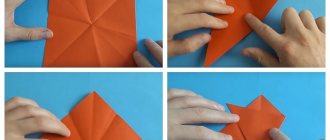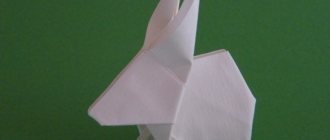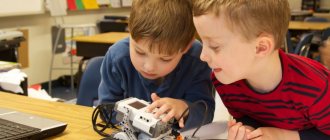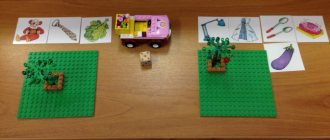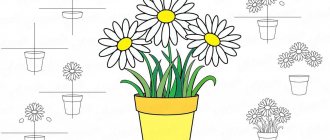Educational games with natural materials
Author's games with tree fruits for children 2-3 years old.
Young children are little explorers. Their interest in natural objects develops gradually, as a result of repeated meetings. When getting to know the world around them, kids want to look at and touch everything. Games with natural materials contribute to the mental and speech development of children, the formation of their cognitive interest, the ability to interact with each other, and the manifestation of creative abilities. In the process of playing together, a friendly attitude towards peers and adults is formed.
One day, when a large round box came into our group, the idea arose to use it to play with the fruits of chestnut, oak, walnut, spruce and pine cones. We divided the interior of the box into four parts and placed animal figures in each of them. The chestnuts, cones, acorns, and walnuts collected by the children were placed in a basket, and slits were made in the lid of the box and pictures with images of these fruits were pasted next to them.
Game "Treats for Friends"
Goal
: to form ideas about the fruits of the trees in the immediate environment.
Tasks
: develop sensory representations when identifying the characteristics of chestnut, oak, walnut, spruce and pine fruits; introduce the texture features of various natural materials; develop attention, memory, mental operations of analysis, comparison, grouping, classification; expand and clarify vocabulary; develop the ability to correlate objects with their images, precise movements of fingers and hands.
Material
: a basket with pine cones, walnuts, chestnuts, acorns, a box with slots, plastic and rubber animal figures.
The game is intended for children 2-3 years old, up to 4 people can take part in it at the same time.
Progress of the game
The teacher brings in a basket with natural material, which is represented by chestnuts, pine and fir cones, walnuts and acorns, and invites the children to examine and examine it. Children place these fruits into the holes on the box after matching their appearance with the adjacent images. After all the fruits have been laid out, the lid of the box is opened and the children are invited to see who got the gifts. Kids can also check whether the game task was completed correctly and move the fruit if a mistake is made. To maintain interest in the game, we replace animal figures, move them to other parts of the box, partially cover photographs of fruits, and add fresh fruit.
Game "One-many"
Goal
: to form an understanding of the concepts of “many” and “one”.
Tasks
: to consolidate the names of the fruits of different trees, to differentiate images of one object and many objects, to learn to put aside the number of fruits corresponding to these images, to consolidate the ability to verbally designate one object and many objects.
Material
: a basket with spruce, pine and cedar cones, pecans, hazelnuts and walnuts, chestnuts, acorns, alder cones; box with slots; cards with images of one of the indicated fruits and many of the same fruits. Up to 4 children can take part in the game.
Progress of the game
The teacher invites preschoolers to examine and name the fruits of the trees that are in the basket, and then find and name the same fruits in the pictures. Then the teacher shows a card with a picture of a chestnut and places it near one of the holes in the box. He invites each participant in the game to drop the same number of chestnuts into it.
Children put one chestnut in a box. After this, the box is opened and offered to see how many fruits are in it. The teacher leads preschoolers to the conclusion that many chestnuts means one chestnut many times. Children are asked to find and show a picture that shows a lot of chestnuts. Similarly, preschoolers produce many other fruits.
Game "Fun Counting"
Goal
: to consolidate the skills of correlating the number of objects with a number.
Tasks
: strengthen the skills of counting objects within 5, indicating the number of objects with a number.
Material
: a basket with natural material, a box with slots, cards with numbers from 1 to 5. Up to 4 children can take part in the game.
Progress of the game
The teacher draws the children's attention to the basket of fruits, invites them to choose one different fruit and name it. Then he shows a card with a number, and the children lower the corresponding number of fruits into the holes of the box, focusing on their images. After this, the teacher opens the lid and offers to check if everyone has completed the task.
We complicate the task by asking the children to put different numbers of fruits in the box. The children, together with the teacher, open the box and count the number of boxes in each compartment. You can introduce an element of mystery into the game and offer to choose fruits from the basket by touch with your eyes closed. In this case, children complete the game task in turns. For example, the first participant closes his eyes and selects 3 chestnuts, the next one gropes for 3 nuts. We add new natural material to the basket, and children become familiar with it based on tactile sensations.
Game “What Grew on a Branch”
Goal
: to consolidate ideas about the characteristic features of tree fruits.
Task
: develop sensory ideas about tree fruits based on tactile sensations.
Material
: a basket with pine cones, nuts, chestnuts, acorns and fruits.
1-4 children can play. The teacher invites the children to identify by touch the fruits of the trees lying in the bag and name them. After this, each child takes out a fruit, and, making sure that his answer is correct, puts it in the box, focusing on the corresponding image.
The presented manual can be successfully used to strengthen preschoolers’ quantitative skills and ideas about parts of plants. It should be noted that introducing children to the possibility of unusual uses of an ordinary box contributes to the development of imagination, interest in experimentation and creative activity.
Valentina Shusharina, additional teacher
arr. Anastasia Trishina, teacher, School 1574, Moscow
Lesson summary “Making a postcard from natural material”
Open lesson summary
«Handmade cards from natural materials.”
Topic: “ Making handmade cards from natural materials”
Purpose of the lesson : To improve students’ skills in working with natural materials, paper using the appliqué technique in the process of making crafts with their own hands - handmade cards from natural materials.
Tasks:
Educational:
- introduce the necessary materials when making a postcard;
— increase students’ independence when performing work tasks;
— learn to work according to a given algorithm;
- strictly observe and implement safety regulations.
Educational:
— develop control and self-control skills, skills of practical work in groups;
- develop fine motor skills of the hands;
- develop students' creative abilities,
- develop cognitive activity, the ability to observe, compare, generalize and draw conclusions.
Corrective:
— practice skills in working with tools;
— develop students’ speech, replenish vocabulary;
- learn how to navigate tasks;
- be able to compare a product with a sample, exercise self-control.
Educational:
— to cultivate the aesthetic taste of students;
— to form a stable positive attitude towards work;
— cultivate accuracy, thrift, and work culture;
- to form an emotionally positive attitude towards the subject being studied, showing the connection of the subjects being studied with life;
- achieve the quality of manufactured products.
Tools, equipment, materials: tree leaves, glue stick, card blanks, scissors, PVA glue, napkins.
Information and communication equipment: multimedia projector, computer.
Visual aids: presentation, templates of postcard parts, finished product sample.
Planned results of the lesson: making a handmade postcard from natural material.
Progress of the lesson.
- . Organizing time
Hello, dear guys, guests!
I am glad to welcome you to this lesson! Today, in our vocational lesson, we are starting to make a new craft.
For work we will prepare our eyes and fingers.
gymnastics for the eyes, gymnastics for the fingers
But tell me what we are going to make. Here's a riddle for you:
presentation on screen, slide No. 1,2
- Updating knowledge, problem statement
The topic of our lesson is HANDMADE CARDS FROM NATURAL MATERIAL.
Today you will learn how to make crafts from natural materials. But first we will get to know what a postcard is.
- Introductory part (theoretical)
Show presentation slide No. 2 - No. 13:
In the encyclopedia, POSTCARDS are postcards or open letters intended to be sent by mail in an open form.
The well-known history of the postcard as a postcard goes back more than 140 years. Over such a long period of existence of the postcard, its appearance and purpose have changed several times.
To escape from the hard everyday life of war and sad thoughts, the soldiers painted their cardboard rectangles.
One of the painted rectangles caught the eye of bookseller Leon Benardot from Brittany. It is possible that this is how the history of the creation of the postcard began.
Greeting cards were the first in history. Thus, the earliest postcard that has come down to us is the “Valentine”. This greeting card is kept by the British Museum in London; it dates back to the 15th century.
The first printed Christmas card was a greeting card designed in 1840 for Sir Henry Cole.
On a card measuring 12*7 cm, the artist drew a family sitting at a festive table, adding the caption: “Merry Christmas and Happy New Year!” He made 1000 greeting cards and they were all mailed in envelopes to numerous acquaintances.
In Russia, the history of creating postcards began later; only in 1872 did the first open letters appear. They were not illustrated, and were made on paper of different colors. Postcards, printed on black paper, could be sent both within the city and to other cities, depending on the stamps attached. Postcards on brown paper were intended for sending within the city, and green ones were intended for sending out of town.
The first black and white photo postcards were hand-colored with watercolors.
The 80s of the 20th century are considered the “golden time” of Russian postcards. Many people collected postcards at this time.
What types of postcards are there?
Postcards are:
- Congratulations
- Promotional
- "Business"
- Musical
- Electronic
- Main part
Watch the cartoon “Three Cats” and answer what the word “postcard” means to you?
How many bright colors appear in nature with the onset of autumn!
And what beautiful autumn crafts can be made from natural materials!
Natural material is what we find in nature, the most accessible material for people who love to make crafts.
You can create toys, images of animals and people from various natural materials.
Different in shape and color, they combine perfectly with each other and complement each other.
The unique appearance of natural materials inspires creativity and the creation of extraordinary works of art. The work that we will make today can be a decoration - a talisman (if you insert a beautiful braid into it), it can be a souvenir, a gift for friends and family that will remind you of autumn.
Today we will make cards with our own hands using tree leaves, because they are all so different and beautiful...
Before starting work, we will conduct a physical training session
-Conducting physical education sessions
- Making a postcard with your own hands
These are the cards we will learn to make today
(tell about all stages of work)
-Conducting physical education sessions
(making a postcard with your own hands)
- Final part
You've worked really hard, and it's time to see what wonderful work we've done.
The works turned out very bright, like autumn itself. Now you can give your fairies to your family and friends. They will certainly please them, because a gift created with your own hands will carry a little warmth from your hands and your soul

